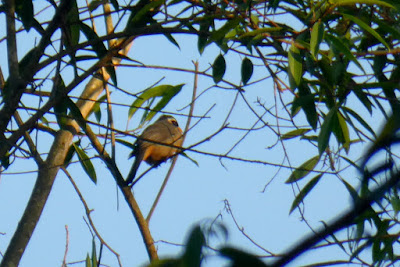I'll organize this in sections. First, wanderings around the MUM campus.
One morning, walking to the Golden Dome, Venus was aligned with a pair of street lights. Click on the image to see Venus above and to the left of the lamps.
As part of celebrating spring, a student organization sponsored a "color fight," secularizing that part of the Holi festival.
I missed the festivities, but here's the stage afterward.
I was driving a new Chrysler Pacifica plug-in hybrid, so I had the impulse to document the charging opportunities here. (There are also two in town, but those are less convenient for someone staying on campus.)
 |
| 120 volt outlets -- bring your own charger |
 |
| 240 volts near the Sustainable Living Center, next to the Peace Palace! |
 |
| 240 volts on the other side, a student OpenEVSE project. |
stoppable only by high-tension power lines further north.
The big news was the cutover of the new "MEG'Array" solar power plant, which generates 1.1 megawatts of power and thus one-third of the university's electrical needs. It's a high-tech installation combining active tracking of the sun with vanadium flow batteries to store power. The shot was taken from the Jefferson County Loop Trail.
This new observation deck is where I stood to grab the picture. The solar farm is just visible through the greenery towards the left -- click on the image to enlarge and scan the horizon.
My last campus photo is another "celestial" photo, taken from the front of the Argiro Student Center.
 |
| Full moon, clouds, and Vedic Observatory |
Of course I also had to explore the town square and its immediate surroundings,
always the site of comings, goings, and stayings of business.
One of my favorite restaurants in Fairfield is the Asian Pho Bistro, just off the square. I was glad to see it still there.
The Tokyo Pen Shop has been replaced by the Copper Moon Cafe. Haven't tried it yet.
An establishment of liquid refreshment, which I also haven't visited. I'm falling behind!
A new shop since March 2018.
A renovation finished.
Someone needed more coffee.
A notice that RAGBRAI (the Register's Annual Great Bicycle Ride Across Iowa) will be coming through in August.
Coming attractions at the Sondheim:
One goal for this visit was to walk the one bit of the Jefferson County Loop Trail that I'd not trod. Last year I had come close but ran out of steam and time. Now I drove to Whitham Woods Park,
where I'd repeat a stretch of trail before tackling the missing link. I soon came across an abandoned pink plastic slipover for walking on ice.
I covered the last stretch and back without any difficulty. The topic of the loop trail deserves and will receive its own blog post, and this one is long enough.
I returned home well rested, having spent two weeks where I wasn't surrounded by the press of daily chores and demands.
























































